Feeding winter birds in Pennsylvania is not only a source of enjoyment for humans, but also a beneficial practice for the birds themselves. While some bird species migrate to escape the harsh conditions, many choose to stay in Pennsylvania during the winter season. Although birds are capable of surviving without human assistance, certain species may benefit from the extra help provided by backyard bird feeders. Residential areas with well-stocked feeders offer a reliable source of food, water, and shelter for birds, particularly the young ones. The act of feeding birds in winter brings joy to bird enthusiasts, provides a connection to nature, and gives a sense of purpose. Pennsylvania is home to a multitude of common winter feeder birds, including Tufted Titmouse, Northern Cardinal, White-breasted Nuthatch, Dark-eyed Junco, Carolina Wren, Song Sparrow, Black-capped Chickadee, House Finch, Downy Woodpecker, Mourning Dove, and Blue Jay. Each bird has specific feeding preferences and can be easily attracted to different types of feeders. For example, birds enjoy feasting on sunflower seeds, suet, nuts, and mixed bird seed blends. By utilizing different feeders, such as hopper feeders, tube feeders, and platform feeders, bird enthusiasts can successfully attract a diverse range of bird species to their backyards. However, it is important to note that while Blue Jays may offer a vibrant splash of color, they can also be aggressive towards other birds. Nevertheless, they can be easily enticed with peanuts and other nuts.
Benefits of Feeding Winter Birds in Pennsylvania
Feeding winter birds in Pennsylvania not only brings enjoyment to bird enthusiasts but also provides numerous benefits for both birds and humans. While many birds stay in Pennsylvania during the winter, some migrate to escape harsher conditions. Although birds can survive without human feeding, certain species may benefit from the extra help provided by backyard bird feeders.
Promotes bird survival
Feeding winter birds in Pennsylvania promotes their survival, especially during the colder months when food sources may be scarce. By providing a constant supply of food, backyard bird feeders ensure that birds have access to the nourishment they need to maintain their energy levels and withstand the challenging winter conditions. This is especially important for young birds who may not have developed the foraging skills necessary to find food on their own.
Provides food and shelter
Backyards in residential areas serve as vital sources of food and shelter for winter birds in Pennsylvania. Bird feeders offer a readily available food source, supplementing the natural food options available during the winter months. Additionally, backyard landscapes with trees, shrubs, and birdhouses provide safe havens where birds can take shelter from harsh weather conditions, such as snowstorms or freezing temperatures.
Helps bird species in need
Feeding winter birds in Pennsylvania can be particularly beneficial for certain bird species that may be more vulnerable during the winter. Some bird species, such as the Northern Cardinal or the Mourning Dove, may struggle to find sufficient food during the colder months. By providing supplemental food through bird feeders, individuals can help support these bird species and increase their chances of survival.
Importance of Backyard Bird Feeding
Backyard bird feeding goes beyond simply providing food for birds during the winter. It has important implications for bird conservation, human well-being, and our connection to the natural world.
Contributes to bird conservation
By feeding winter birds in Pennsylvania, individuals can contribute to bird conservation efforts. Many bird species face declining populations due to habitat loss, climate change, and other factors. Backyard bird feeding plays a small but meaningful role in supporting these bird populations by providing them with the necessary resources to survive and thrive.
Brings joy and connection to nature
Watching and interacting with winter birds in the backyard brings immeasurable joy and a unique connection to nature. The vibrant plumage, melodious songs, and lively behaviors of these feathered visitors can provide hours of entertainment and relaxation. It offers a wonderful opportunity to observe and appreciate wildlife from the comfort of one’s home, fostering a deeper appreciation for the natural world.
Instills a sense of purpose
Feeding winter birds in Pennsylvania gives individuals a sense of purpose and responsibility. By taking care of these vulnerable creatures, people can make a positive impact on their lives and contribute to the well-being of the local ecosystem. It provides an opportunity for individuals to actively engage with nature, fostering a sense of stewardship and environmental consciousness.
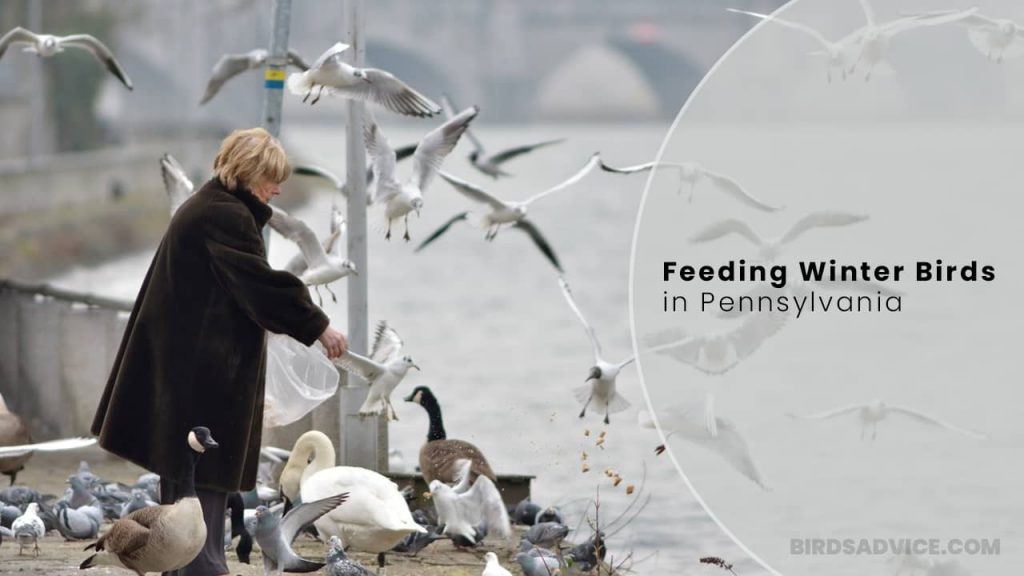
Common Winter Feeder Birds in Pennsylvania
Pennsylvania is home to a diverse range of winter feeder birds, each with its unique characteristics and preferences. Getting to know these common winter feeder birds can help individuals attract them to their backyard feeders.
Tufted Titmouse
The Tufted Titmouse is a small, lively bird with a distinctive crested head. They often visit feeders for sunflower seeds and suet. Easily recognizable by their soft gray plumage and rusty flanks, Tufted Titmice are a delight to watch as they dart around feeders.
Northern Cardinal
The Northern Cardinal is a beloved backyard bird known for its stunning red plumage and melodic song. These birds enjoy sunflower seeds and can often be found hopping around platform feeders. Cardinals are a year-round resident of Pennsylvania, and their bright colors bring a welcome splash of vibrancy in the winter.
White-breasted Nuthatch
The White-breasted Nuthatch is a small, agile bird often seen crawling along tree trunks headfirst. They have a distinct black cap and a white face, with a sturdy beak that helps them extract seeds from cracks and crevices. Nuthatches are particularly fond of peanuts and sunflower seeds and are frequent visitors to tube feeders.
Dark-eyed Junco
The Dark-eyed Junco, also known as the “snowbird,” is a common winter visitor in Pennsylvania. These small, gray birds with white bellies can be found foraging on the ground for spilled seeds and enjoy mixed bird seed blends. Their presence adds a touch of charm to winter landscapes.
Carolina Wren
The Carolina Wren is a small, round-bodied bird with a distinctive upward-curving tail. These energetic birds are known for their loud, melodious songs. They prefer platform feeders where they can easily access their prey, which includes insects, suet, and seeds.
Song Sparrow
The Song Sparrow is a familiar bird with a repertoire of beautiful songs. Their brown plumage is adorned with streaks and spots, giving them a charming appearance. Song Sparrows are frequent visitors to hopper feeders, where they feed on a variety of seeds and occasionally suet.
Black-capped Chickadee
The Black-capped Chickadee is a friendly, charismatic bird known for its cheerful calls and acrobatic antics. Sporting a black cap and bib, with white cheeks and gray wings, these birds enjoy sunflower seeds and suet. They are quick to adapt to various types of feeders, making them delightful guests to any backyard.
House Finch
The House Finch is a small, finch-like bird with a colorful plumage ranging from red to yellow. This species has a fondness for sunflower seeds and can often be found feasting on them at tube feeders. Adding a splash of color to winter landscapes, House Finches are a delight to observe.
Downy Woodpecker
The Downy Woodpecker is the smallest woodpecker in North America and a frequent visitor to backyard feeders. With its black and white plumage and distinctive white spots on its wings, it’s easy to identify. Downy Woodpeckers enjoy suet and will readily feed from suet feeders.
Mourning Dove
The Mourning Dove is a gentle and peaceful bird recognized for its soft cooing calls. It has a plump body, a long, pointed tail, and muted brown feathers. Mourning Doves prefer feeding on the ground, so offering mixed bird seed blends or scattered seeds is an excellent way to attract them.
Blue Jay
The Blue Jay is a striking bird known for its brilliant blue plumage and crest atop its head. It is a vocal and charismatic visitor to feeders. Blue Jays enjoy a varied diet, including nuts, fruits, and seeds. Providing peanuts can be particularly enticing to these birds, although they may intimidate other feeder birds with their aggressive behavior.
Feeding Preferences of Winter Birds
Understanding the feeding preferences of winter birds in Pennsylvania is essential for attracting them to backyard feeders. By offering their preferred foods, individuals can create a welcoming space that entices these feathered friends.
Sunflower seeds
Sunflower seeds are a popular choice among many winter feeder birds, such as Tufted Titmice, Northern Cardinals, Black-capped Chickadees, House Finches, and more. These nutritious seeds provide birds with essential fats and proteins, helping them maintain their energy levels during the winter.
Suet
Suet is a high-energy, pure fat substance that offers a valuable food source for birds during the colder months. Birds like White-breasted Nuthatches, Black-capped Chickadees, and Downy Woodpeckers are particularly fond of suet. Suet feeders can be filled with suet cakes or homemade suet mixtures that may include nuts, seeds, and dried fruits.
Nuts
Nuts, such as peanuts and almonds, attract birds like Carolina Wrens, Blue Jays, and various woodpecker species. These protein-rich treats offer both nutrition and entertainment, as birds may spend time cracking them open to access the tasty kernels inside. Peanuts in the shell can be placed on platform feeders, while shelled nuts can be offered in mesh feeders.
Mixed bird seed blends
Mixed bird seed blends are a versatile option that can attract a wide variety of winter feeder birds. These blends typically include a mixture of seeds like millet, cracked corn, and sunflower seeds. Birds like Dark-eyed Juncos, Song Sparrows, and Mourning Doves are among those that enjoy these blends.
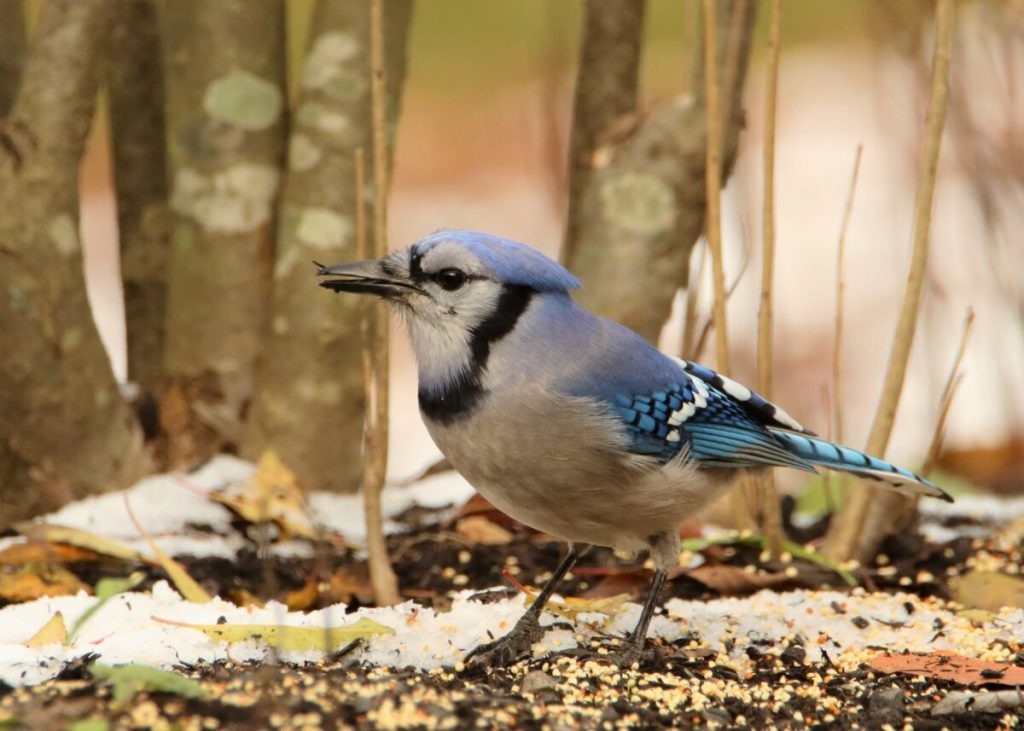
Types of Feeders
Choosing the right type of feeder is crucial for attracting specific bird species. Different feeders cater to various feeding styles and preferences, ensuring that a diverse range of winter birds can enjoy the offerings.
Hopper feeders
Hopper feeders are versatile and popular among many winter feeder birds. These feeders consist of a container with openings on multiple sides, allowing birds to perch and access the food. Hopper feeders can accommodate a range of food, including mixed seed blends, sunflower seeds, and cracked corn. Their design also helps protect the food from getting wet and spoiling.
Tube feeders
Tube feeders are long, cylindrical feeders with multiple feeding ports. These feeders are suitable for smaller birds like finches and chickadees that can cling to the feeder while accessing the seeds. Tube feeders are commonly filled with sunflower seeds or nyjer thistle, attracting species such as Black-capped Chickadees, House Finches, and Tufted Titmice.
Platform feeders
Platform feeders consist of an open tray where birds can easily access the food. They are suitable for ground-feeding birds like Mourning Doves and Dark-eyed Juncos. Platform feeders can be filled with various types of seeds, suet, or leftovers from other feeders, providing a diverse feeding option for different bird species.
Attracting Specific Bird Species
Each bird species in Pennsylvania has unique preferences when it comes to feeding. By tailoring the offerings and creating an inviting environment, individuals can increase their chances of attracting their desired bird species.
Tufted Titmouse
To attract Tufted Titmice, provide a mix of sunflower seeds and suet. Placing feeders near tree cover or shrubs can entice these birds, as they prefer to have nearby perching spots and cover for protection.
Northern Cardinal
Northern Cardinals can be lured with sunflower seeds. Offering feeders with larger perches and positioning them in open, visible locations can make it easier for Cardinals to find and access the food.
White-breasted Nuthatch
White-breasted Nuthatches are fond of suet and peanuts. Place suet feeders in trees or on posts, making sure they are easily accessible for these acrobatic birds.
Dark-eyed Junco
Dark-eyed Juncos enjoy ground-feeding, so scattering mixed bird seed blends or millet on the ground can attract them. Additionally, offering low platform feeders with these food options can make them feel safer while feeding.
Carolina Wren
Carolina Wrens are insectivores but also enjoy dining on suet and seeds. Providing a mix of suet, nuts, and seeds in platform feeders or offering a suet cake in a suet feeder can entice these vocal birds.
Song Sparrow
Song Sparrows prefer hopper feeders filled with a variety of seeds. Placing feeders in shrubbery or near dense vegetation can attract these birds, as they appreciate the cover and protection.
Black-capped Chickadee
Black-capped Chickadees are known for their love of sunflower seeds and suet. Tube feeders filled with sunflower seeds and suet feeders are both excellent options for attracting these lively and acrobatic birds.
House Finch
House Finches enjoy sunflower seeds and can be attracted to tube feeders or hopper feeders. Offering feeders with perches and placing them in open areas can increase the chances of attracting these colorful finches.
Downy Woodpecker
Downy Woodpeckers are drawn to suet feeders filled with pure suet or suet cakes. Placing these feeders near trees or post-mounted feeders can mimic the woodpecker’s natural foraging environment.
Mourning Dove
Mourning Doves prefer feeding on the ground or low platform feeders. Offering mixed bird seed blends or scattered seeds near ground cover can attract these gentle birds to the backyard.
Blue Jay
Blue Jays can be attracted with peanuts, preferably in the shells. Placing these nuts on platform feeders or offering them in mesh feeders can entice Blue Jays while deterring other feeder birds due to their aggressive behavior.
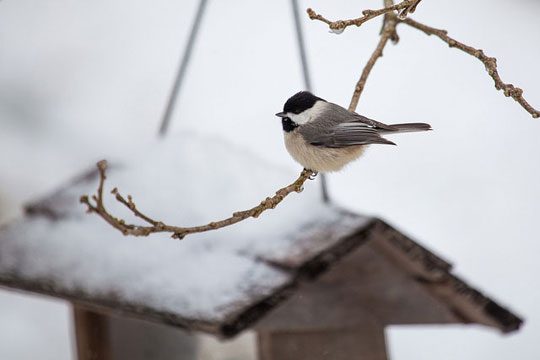
Understanding Blue Jays’ Feeding Habits
Blue Jays are a distinctive winter bird in Pennsylvania known for their brilliant blue plumage and their assertive behavior. Understanding their unique feeding habits can help individuals create an environment that accommodates their needs.
Aggressive behavior towards other birds
Blue Jays are known for their assertive behavior, sometimes engaging in aggressive interactions with smaller or less assertive birds at feeders. Their presence may discourage other bird species from feeding, as Blue Jays can be territorial and dominant in their feeding habits. To mitigate this, placing additional feeders or offering alternative food sources can ensure that smaller birds have access to food even in the presence of Blue Jays.
Preference for peanuts and nuts
Blue Jays have a particular fondness for peanuts and other nuts. They can be enticed with peanuts in the shell or shelled peanuts placed on platform feeders or offered in mesh feeders. Providing a consistent supply of these preferred foods can increase the chances of attracting Blue Jays to the backyard.
Factors to Consider for Successful Bird Feeding
Several factors can contribute to the success of bird feeding efforts in Pennsylvania. By considering these factors, individuals can create an optimal feeding environment that benefits both birds and humans.
Choosing the right feeder location
Placing feeders in locations that offer safety and convenience for birds is essential. Positioning feeders near trees or shrubs provides birds with nearby perching spots and cover for protection. Additionally, locating feeders in open, visible areas can make it easier for birds to find the food and for individuals to observe their feathered visitors.
Providing clean and fresh water
Offering clean and fresh water is crucial, especially in the winter when natural water sources may freeze. Bird baths or shallow dishes can be filled with water and checked regularly to ensure they are not frozen or contaminated. Providing fresh water alongside food sources will attract more birds to the backyard and promote their well-being.
Creating a bird-friendly environment
Creating a bird-friendly environment goes beyond feeders and food. Incorporating native trees, shrubs, and plants in the backyard can provide additional food sources and nesting opportunities for birds. Providing a variety of vegetation throughout the year ensures that birds have habitat and resources throughout their life cycles.
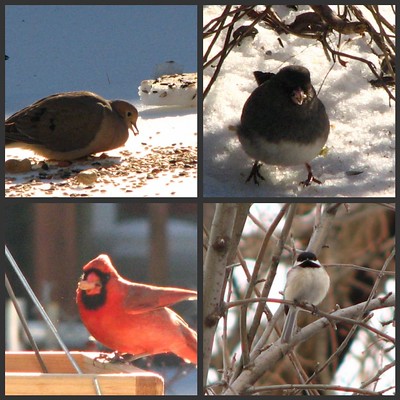
Winter Bird Feeding Tips
Feeding winter birds in Pennsylvania can be a rewarding experience. To maximize the benefits and attract a diverse range of bird species, consider these tips when setting up and maintaining bird feeders.
Consistency in feeding schedule
Maintaining a consistent feeding schedule is essential for attracting and retaining winter birds. Birds rely on a steady food source, so establishing a routine and replenishing feeders regularly will ensure that birds know when to visit and have access to the nourishment they need.
Protecting feeders from harsh weather
Winter weather in Pennsylvania can be harsh, affecting the availability and quality of bird food. Protecting feeders from snow, rain, and strong winds can help maintain the food’s freshness and prevent it from spoiling. Installing baffles, shelters, or placing feeders in covered areas can offer protection and ensure that birds have access to food during inclement weather.
Avoiding overcrowding and disease transmission
Bird feeders can be gathering places for various bird species, which may increase the risk of overcrowding and disease transmission. To prevent overcrowding, providing multiple feeders spaced apart can distribute the bird population and reduce competition. Additionally, regularly cleaning and disinfecting feeders can limit the spread of diseases among the birds.
Enjoying the Rewards of Winter Bird Feeding
Feeding winter birds in Pennsylvania offers numerous rewards beyond the satisfaction of benefiting bird populations. Observe, document, and contribute to the scientific community while enjoying the wonders of avian life in the backyard.
Observing bird behavior and interactions
Feeding winter birds provides a unique opportunity to observe their behaviors, interactions, and feeding patterns up close. Witnessing social dynamics, territorial disputes, and courtship rituals can offer fascinating insights into avian life and behavior. Bird feeding becomes not just an act of providing food but a window into the captivating world of birds.
Photographing or documenting bird species
Winter bird feeding opens the door to capturing beautiful photographs and documenting the presence of different bird species. Capturing these moments on camera or keeping notes in a journal can create lasting memories and contribute to personal fulfillment. It also allows individuals to contribute to citizen science projects and contribute valuable data to support bird conservation efforts.
Contributing to citizen science projects
Participating in citizen science projects adds another layer of connection and purpose to winter bird feeding. Various organizations and initiatives offer opportunities for individuals to report sightings, behavior, and population trends. Contributing data to these projects can contribute to scientific research and conservation efforts that protect and preserve bird species.
In conclusion, feeding winter birds in Pennsylvania provides a meaningful and enjoyable experience for both birds and humans. By promoting bird survival, providing food and shelter, and helping bird species in need, individuals can make a positive impact on avian populations. Backyard bird feeding contributes to bird conservation, brings joy and connection to nature, and instills a sense of purpose. Understanding the feeding preferences of common winter feeder birds, choosing the right types of feeders, and attracting specific bird species enhances the experience. Factors such as feeder location, clean water provision, and creating a bird-friendly environment increase the chances of successful bird feeding. By following practical tips and enjoying the rewards of winter bird feeding, individuals can cultivate a deeper appreciation for the wonders of avian life and contribute to the well-being of these feathered creatures.
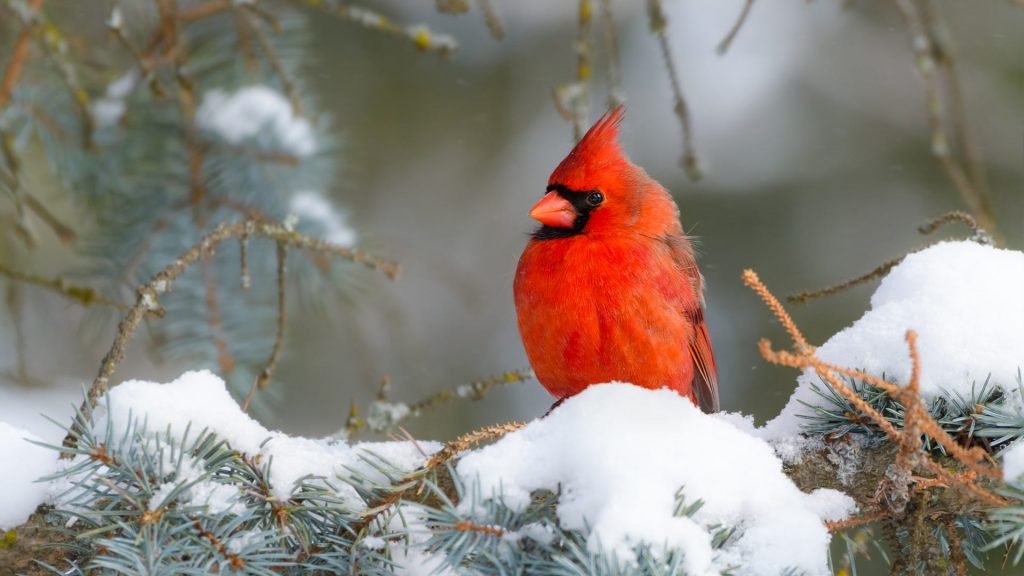
Leave a Reply